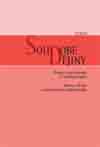Nechtěné Slezsko. Reflexe českého „slezanství“ v poválečném Československu (1945–1969)
Unwanted Silesia: Reflections of Czechs ‘Silesianness’ in Post-war Czechoslovakia, 1945–69
Author(s): Jiří Knapík , Zdeněk JirásekSubject(s): History
Published by: AV ČR - Akademie věd České republiky - Ústav pro soudobé dějiny
Summary/Abstract: Czech Silesianness, obvious throughout the twentieth century, was based on a mixture of strong regional, even local, patriotism, which was determined by historical developments. This patriotism developed on the ethnically mixed territory of Czech Silesia (formerly Austrian Silesia). After the Second World War this phenomenon was quickly revived, bit unlike the pre-war period, it took a clearly Czech national form. The territorial factor, by contrast, receded into the background. Behind this activity and new interpretation stood intellectual circles and institutions in Opava, some leading figures from Ostrava, and the Silesian Cultural Institute in Prague. In addition to cultural-educational activity, their efforts were concentrated on claiming some border areas of Polish and German Silesia as being historically Czech, and also on ensuring the distinctive administrative status of the territory of Silesia in Czechoslovakia, the seed of which they saw in the Ostrava branch of the Moravian National Committee (Zemský národní výbor) in Brno. During the Communist régime, according to the authors, the top state authorities showed an intentional lack of interest in the problems of Silesia when solving related economic and other questions. A consequence of this was a ‘silencing of the official sources’ about Silesia. In the 1950s, ‘Silesianness’ was condemned as a form of ‘bourgeois nationalism’ and was identified with the period of Czech- Polish national friction in the region. From the administrative point of view Silesia was dissolved in the Ostrava area, later in the North Moravian Region, and was recalled practically only by artistic expressions of an ‘antiquated Silesianness’, such as folklore and museum exhibitions. Silesian organizations and societies were, with few exceptions, dissolved or renamed and the newly established Silesian Research Institute in Opava had to orient its historical research chiefly to the labour movement. The works of the poet Petr Bezruč (born Vladimír Vašek, 1867–1958) and his collection of verse, Slezské písně (Silesian Songs), presented a problem because of their questionable depiction of Silesian identity, and the publication of the complete collection led to disputes in cultural policy. The Ostrava-based arts and politics periodical Červený květ (Red Flower), which repeatedly included debates about regionalism, began to be published in the mid-1950s. At the end of the decade, however, the Communist Party launched a campaign against parochialism (lokálpatriotismus), which was refl ected also in the condemnation of publications seeking to exonerate the poems and ideas of Óndra Łysohorsky (born Ervín Goj, 1905–1989), who during the war promoted the theory of a ‘Lach nation’. In the 1960s the local authorities and fi gures of Opava again began to emphasize the role of their town as a regional centre.
Journal: Soudobé Dějiny
- Issue Year: XVII/2010
- Issue No: 03
- Page Range: 421-440
- Page Count: 20
- Language: Czech

